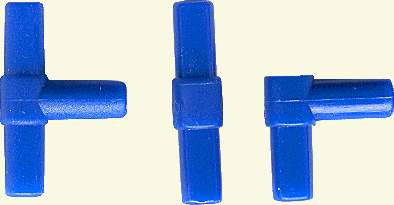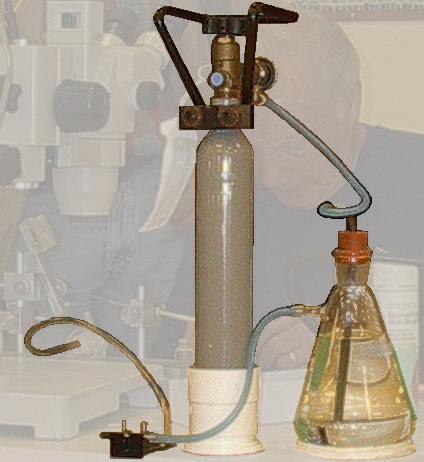
CO2 is a heavier than air gas that can displace oxygen in a closed environment, ensure adequate ventilation at low level in rooms where it is used.
CO2 has been collected from Bottles of fizzy drink by John Pollard, which shows how simple the process can be, but in general most instrumental insemination takes place with gas from pressure bottles.
The Set up shown at right belongs to Ron Hoskins, the gas delivery system is highlighted with the rest of the picture ghosted so that the full relationship of all of the parts can be seen. Ron is a member of Bee Instrumental Insemination Group (BIIG) and this photograph was taken at a BIIG meeting in June 2005. BIIG also have their own website.
Bottled CO2 is readily available for use in carbonated drinks machines, and is already very 'clean', because it is supplied to food standards. The grey cylinder illustrated below came from a "SodaStream" soft drinks making machine and brass fittings to mate with it came from a kit used to pressurise "home brewed" beer barrels (manufactured by Boots). The one used in Ron's set up is one of the sodastream type, but other types (often much larger) are available from the drinks trade. Refills are readily available, but consumption of CO2 is very low and so even a small bottle will last a season or more, before re-filling. If you purchase your gas from a beer delivery business be careful to establish that the gas is only CO2 as some beer delivery is done using a mix of CO2 and Nitrogen.

Pressure regulators that are intended for compressed air operation are also suitable for use with CO2. They may be purchased new from pneumatics supply houses or as in my case I scrounged a second hand one from a local packaging machine manufacturer. The one illustrated at right has a plastic body, but is almost identical to the diecast metal one that is of Norgren manufacture.

Pressure regulators that are intended for compressed air operation are also suitable for use with CO2. They may be purchased new from pneumatics supply houses or as in my case I scrounged a second hand one from a local packaging machine manufacturer. The one illustrated at right has a plastic body, but is almost identical to the diecast metal one that is of Norgren manufacture.
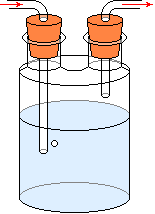
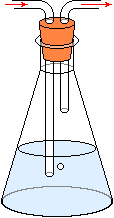
Woulff's Bottles, developed by a British chemist, Peter Woulfe in 1767, who used a bottle with two separate necks (f or ff in spelling seem to be both used). Also known as bubble bottles, they can be used as a delivery rate monitor and to remove any unwanted contaminants from the carbon dioxide itself by use of suitable liquids in the body of the bottle. The direction of flow is indicated by the arrows. Bubble rate always seems to be stated at one per second, but the actual delivery rate at that frequency will depend on the diameter of the tubing at the point the bubble forms (which governs bubble volume).
(qualitative testing needed, put calibrated chart here)
Any bottle and tubing may be used for this purpose providing it can be sterilised and the tubes are sealed in the cap. Distilled or de-ionised water can be used or any type of saline solution.
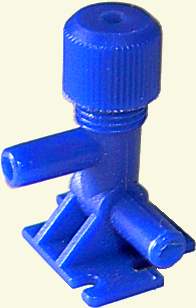
Final rate limiters... Small flow rate limiters or adjusters are available from aquarium suppliers and are intended to regulate the amount of oxygenation bubbles in a fish tank. Made of plastic these are inexpensive. The one illustrated at right has a base 19.5 mm x 24.5 mm and 5 mm diameter nipples. Regulation is achieved by a tapered needle that can be inserted or withdrawn by the action of the knurled cap which engages the threaded portion of the valve body.
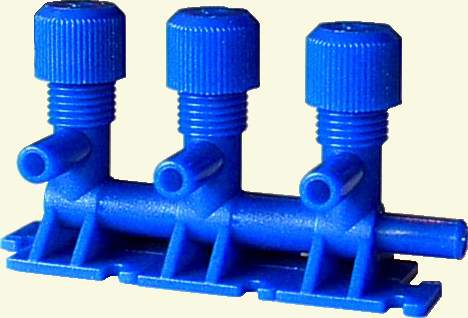
The triple bank version shown at left can be pulled to pieces and any number can be banked together. These valves can be stuck down to a flat surface using double sided sticky pads.
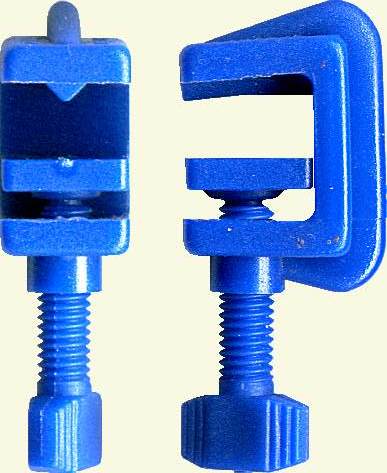
Also available from aquarium suppliers is a blue plastic clamp that is designed specifically for squeezing the 4 mm bore tubing shown further down the page. This is shown larger than life, the actual width being only 11 mm.
The two smaller views show the device in use, sorry about the poor image quality.
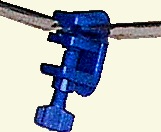
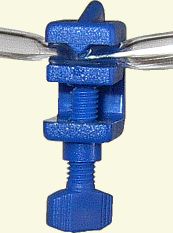
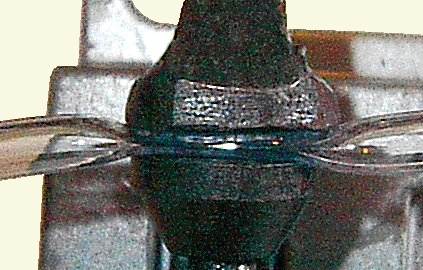
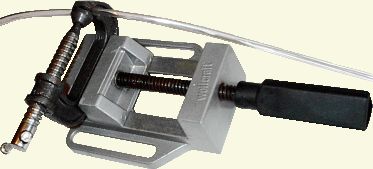
If a piece of soft plastic tubing is used in parts of the system a crude, but effective, method of regulating the bubble rate is to place a carpenter's "G" clamp ("C" cramp) in such a way as to flatten the plastic tube. This is similar in action to a "Mohr clip" that can be used on rubber tubing in the same way. You will need to clean out any swarf or dirt from the thread of the clamping screw and by lubricating it with petroleum jelly, a smooth action will result.
Producing CO2 Gas by chemical means is relatively simple, but the resulting gas will need to be washed or 'scrubbed' in one or more extra Woulfe bottle stages. The usual 'school chemistry lab' method is to use a
Kipps apparatus to react sulphuric or hydrochloric acid with 'marble chips'. The Kipps apparatus is merely a way of reacting a solid and a liquid to produce a gas... In the case of the one illustrated in the link the gas produced is di-Hydrogen sulphide, but the principle is the same. Once the principle of operation of the device is understood it is possible to use 'half gallon' glass cider demijohns with rubber bungs and the use of hard and soft plastic tubing. The generation rate required is very low and can be achieved by using acid that is diluted to a low strength with water.
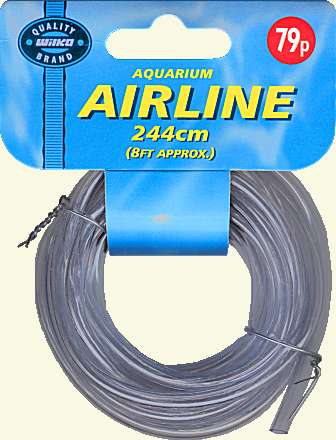
The CO2 gas may be transported around your bench top, using soft plastic tubing that is also available from aquarium suppliers and is only a few pennies or cents per metre.
The aquarium suppliers reference it a 6 mm tubing, because they use the external dimension, the bore is a nominal 4 mm diameter and will fit on the nipples and adaptors illustrated on this page.
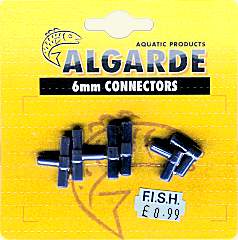
The plastic tube can be joined together and angles negotiated by small plastic adaptors and "T" pieces. These are also available from the aquarium supply shops. The package that they come in is illustrated at right and a close up of the individual items is shown below
